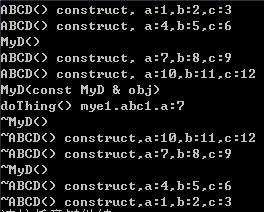C++类构造析构调用顺序训练(复习专用)
Posted
tags:
篇首语:本文由小常识网(cha138.com)小编为大家整理,主要介绍了C++类构造析构调用顺序训练(复习专用)相关的知识,希望对你有一定的参考价值。
//对象做函数参数 //1 研究拷贝构造 //2 研究构造函数,析构函数的调用顺序 //总结 构造和析构的调用顺序 #include "iostream" using namespace std; class ABCD { //this() public: ABCD(int a, int b, int c) { this->a = a; this->b = b; this->c = c; printf("ABCD() construct, a:%d,b:%d,c:%d \n", this->a, this->b, this->c); } ~ABCD() { printf("~ABCD() construct,a:%d,b:%d,c:%d \n", this->a, this->b, this->c); } int getA() { return this->a; } protected: private: int a; int b; int c; }; class MyE { public: MyE() :abcd1(1, 2, 3), abcd2(4, 5, 6), m(100) { cout << "MyD()" << endl; } ~MyE() { cout << "~MyD()" << endl; } MyE(const MyE & obj) :abcd1(7, 8, 9), abcd2(10, 11, 12), m(100) { printf("MyD(const MyD & obj)\n"); } protected: //private: public: ABCD abcd1; //c++编译器不知道如何构造abc1 ABCD abcd2; const int m; }; int doThing(MyE mye1) { printf("doThing() mye1.abc1.a:%d \n", mye1.abcd1.getA()); return 0; } int run2() { MyE myE; doThing(myE); return 0; } // int run3() { printf("run3 start..\n"); ABCD abcd = ABCD(100, 200, 300); //用临时对象来初始化一个对象,就会把临时对象变化成要初始化的对象,而不会调用copy构造函数,临时对象也不用将自己赋值给对方,然后自己销毁这么麻烦. //ABCD(400, 500, 600); //临时对象的生命周期 printf("run3 end\n"); return 0; } int main() { run2(); //run3(); system("pause"); return 0; }
输出\

以上是关于C++类构造析构调用顺序训练(复习专用)的主要内容,如果未能解决你的问题,请参考以下文章